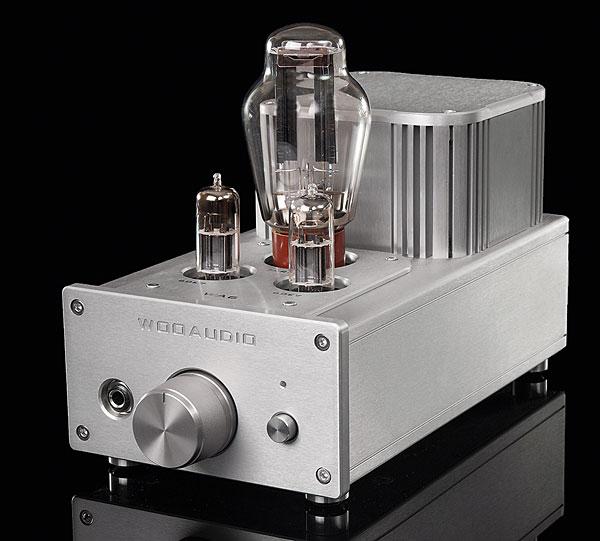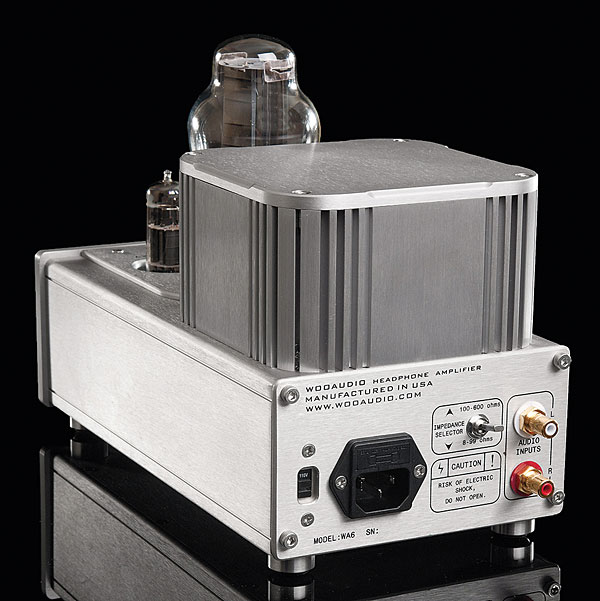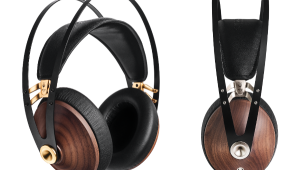Woo Audio WA6 Headphone Amplifier

AT A GLANCE
Plus
Warm, tubey sound
Headphone impedance switch
New York born and bred
Minus
No DAC
Too polite for some
headphones
THE VERDICT
Woo Audio’s WA6 is a Class A headphone amp whose glowing tubes are voiced to warm up any headphones.
The glow of vacuum tubes has fascinated me all my life. When I was a kid, my parents bought a Magnavox console TV with a built-in phonograph and AM/FM radio, the early-1960s equivalent of a home theater system with all the trimmings. It stood on 18-inch legs, and I loved to crawl under it, lying on my back to stare up into the orange glow of the tubes. My first few audio systems were solid state, but a cadre of die-hard audiophiliacs never really gave up on tubes. Now they’ve also wiggled back into my life and onto my desk, where the Woo Audio WA6 headphone amplifier sits, with three glowing obelisks keeping the retro audio flame alive.
Why use a headphone amp at all? To power headphones that are too demanding overall for the flea amp built into your smartphone, or to add a new level of dynamics to your headphone listening that just wasn’t there to begin with. Why make it a tube amp? Mainly for voicing: Tube amps are the spinmasters of audio, able to change character noticeably depending on the circuit they’re used in, the quality and implementation of the output transformers, and the internal construction of the tubes themselves. Despite popular misconception, engineers will tell you that tube amps can be designed to sound harsh and glary if desired. However, most manufacturers have found success exploiting the inherently graceful overload characteristics of these bottled-up thermionic devices and allowing them to bathe everything in a warm, golden glow of benign second-order distortion. Some might describe a tube amp as a tone control of sorts, with just one setting—but what a setting, what a tone! And you’re free to tweak it, the slow, old-fashioned way, with tube rolling—the practice of changing tubes to change the sound. Doing that with the WA6, and doing it right, would have taken me years, but the manufacturer gave me a push in the right direction by shipping the review unit with step-up tubes. More about that in a moment.
Founded in 2004 by the Wu family, a father and two sons, Woo Audio is based in Long Island City, New York. Though its product line consists of about a dozen tube-based headphone amps, the Woo Website boasts a stereo power amp, a monoblock, a DAC, a CD transport, and headphone stands in addition to headphones from other manufacturers. Pricing for head- phone amps ranges from $599 to $15,900. I’d be remiss in not mentioning the WA7 Fireflies, Woo’s stunning glass-encased DAC-amp combo, $999 or $1,398 with solid-state or tube power supply, respectively. But the subject of this review is the more affordable WA6, a pure headphone amp starting at $699 (without upgrades).

Class A All the Way
The WA6 is available in black or silver. Pictures don’t do it justice. You can’t fathom how beautiful it is until you see it, and you can’t appreciate how heavy and well made it is until you handle it. At just 5.5 inches wide, it slipped onto my rack with enough shelf space left beside it for a Blu-ray player and cable box. That’s where it got its break-in listening. For formal demos, I moved the amp onto my desk, where it mated with a Meridian Direct USB DAC and a Lenovo Windows 7 desktop PC.
The thick metal faceplate has a power button, volume knob, and ¼-inch headphone jack. On the back panel are a single set of analog RCA inputs and a power jack along with an impedance switch that toggles between settings for compatibility with headphones having nominal impedances of 8 to 99 or 100 to 600 ohms. The amp could run any of my headphones at either setting, though the more demanding Sennheiser HD600 required an extra twist of the volume control unless I toggled to the higher impedance.
The unit does not ship with a power cable (you may have a couple of leftovers in the closet). So I plugged in an AudioQuest NRG-X3 ($69, 0.9-meter). Why? Because it was there. The analog output of the DAC was connected with half-meter Silver Serpent interconnects from bettercables.com ($60, half-meter)—heavily used in my reference sur- round system but rarely credited; a generic USB cable ran from my PC to the DAC. I also used Grado’s headphone extension cable ($50, 15 feet) when the amp sat on the rack, but not when it moved to the desk.























































